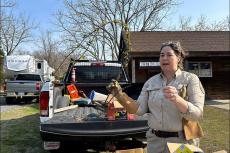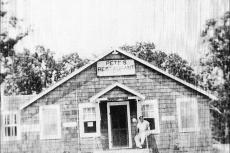East Hampton Town could convert all of its streetlights to light-emitting diodes, or LEDs, before next Memorial Day weekend, realizing both energy and cost savings as well as improved visibility and less glare and light trespass, the town board was told on Tuesday.
Jeff Laino of the New York Power Authority, a state agency that among other functions helps municipalities implement energy efficiency projects, including conversion to LED street lighting, pitched a ready-to-use project that would see the conversion of 729 existing streetlights to LED models. He also proposed that the town enter a shared services agreement with Sag Harbor Village, where around 300 more streetlights would be replaced.
Streetlights in downtown Montauk were converted to LED a few years ago. Converting the other 729 "will have great impact" on the town's carbon footprint, said Lauren Steinberg, a senior environmental analyst in the town's Natural Resources Department. Southampton Town is among several Long Island municipalities and more than 200 others across the state that NYPA is assisting to convert their streetlights, typically from high-pressure sodium lamps.
Streetlights are often a municipality's largest energy consumer, Mr. Laino said. The power authority is about halfway to the Smart Street Lighting NY program's goal of converting at least 500,000 streetlights to LED technology by 2025. It will install number 250,000 in that effort in Malverne this month.
LEDs are directional, reducing light pollution. They distribute light uniformly, reducing dark spots between streetlights, and allow the human eye to detect colors better, improving motorists' ability to see pedestrians and potential hazards.
"LEDs can outperform any other lighting technology," Jean Paul Freyssinier, a senior research scientist at Rensselaer Polytechnic Institute's Lighting Research Center, told the board via video conference. The technology is mature, he said, and the reduction in energy consumption achieved by converting to LED is typically between 50 and 70 percent.
LEDs can be operated by a timer and are dimmable. They last 20 to 25 years, Mr. Laino said, "even longer if you do a dimming schedule, so the diodes last longer accordingly."
The power authority's "turnkey" project implementation includes evaluation, design, procurement, and construction; it can also include project financing and maintenance.
"You would get a dedicated project manager, a NYPA staff person to manage contractors and labor install, as well as any environmental review," Mr. Laino said. NYPA would manage construction and labor, see that a prevailing wage was paid to workers, and ensure the safety of pedestrians, vehicles, and workers during construction.
Mr. Laino estimated a total project budget of just under $470,000 and annual cost savings to the town of $50,000. Townwide conversion to LED would pay for itself in 9.39 years, he said.
A shared services arrangement with Sag Harbor Village would render both municipalities eligible for grants of 95 percent of first-year savings, Mr. Laino said. NYPA would assist in developing a shared services plan in coordination with Suffolk County.
Should the municipalities decide to proceed, design work could begin in September and last about three months, he said. A design report could be produced by December, and once the project's specifics are agreed upon, materials could be delivered in February.
NYPA's contractor installs 20 to 25 LEDs per day, he said, predicting an 8-to-10-week installation between March and May.
"It could be done before Memorial Day, when all of the fun and havoc begins," he said.



